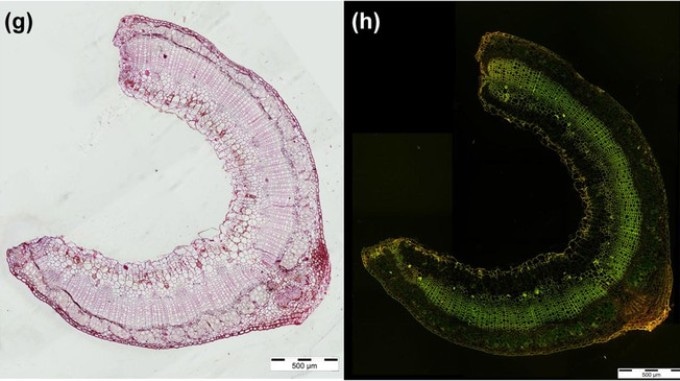Oct 13 2017
Researchers from EPFL’s Laboratory for Processing of Advanced Composites (LPAC) as well as from the Botanical Garden of the University of Freiburg have investigated how the self-repair nature of the flax plant heals upon being damaged.
Working on a cross-disciplinary EU research project, they evaluated alterations in the mechanical properties of the plant (e.g. damping and stiffness) and investigated the self-healing mechanisms of the plant. Due to the fact, composite materials are now being largely synthesized from natural fibers, in-depth knowledge of the process behind such mechanisms can assist Researchers in producing self-repairing materials that have superior performance, making use of techniques influenced by nature. The study was recently reported in the journal PLOS ONE.
 Cross section of a Linum “Drakkar” stem with a 26-day-old wound parallel to the fibers. CREDIT: 2017 Cloé Paul-Victor, Albert-Ludwigs-Universitat Freiburg.
Cross section of a Linum “Drakkar” stem with a 26-day-old wound parallel to the fibers. CREDIT: 2017 Cloé Paul-Victor, Albert-Ludwigs-Universitat Freiburg.
Consider car paint with the ability to automatically self-repair following a scratch, or a corrosion-resistant coating potentially restoring by itself once it is chipped off. These are only two of the prospective and innovative uses of self-healing materials, despite the fact that there are many glitches in adopting these materials.
Each type of material poses a different challenge. Some materials can already regenerate thanks to a system of liquids inside them. If the material is scratched, the liquid flows out and reacts with the surrounding air, for example, to fill in the scratch. It’s similar to how your blood coagulates if you cut your finger.
Véronique Michaud, one of the Authors of the study and the Head of the LPAC
However, other materials are even more complex and advancement is stuck at the laboratory stage. It specifically holds well in the case of composite materials used in aircraft and sporting equipment, upon which lies the interest of the Researchers.
Changes in plants’ mechanical properties
In the wild, plants have to cope with a range of stresses (e.g. rain, wind and damage). This is the reason behind the interest of the Researchers in analyzing the way the flax plants’ stems change upon being damaged.
We chose flax because its fibers are already used to make composite materials, and because it’s a common plant that grows quickly.
Véronique Michaud, one of the Authors of the study and the Head of the LPAC
They created crosswise and lengthwise cuts in the stems of two disparate types of flax plants and allowed them to grow for 25 days adjacent to plants that were not cut. Then, they evaluated alterations in the damping and stiffness characteristics of the stems. The Researchers—including EPFL Researchers as well as a Biology Post-Doctoral Researcher from the University of Freiburg—administered a dynamic tensile load to the stems to estimate the force needed to stress the plants as well as their temporal response, for both intact and self-repaired stems.
Damping and stiffness are the characteristics that Scientists repeatedly attempt to enhance in materials. They must always find the right trade-off between these two factors, whether the aim is to avoid uncomfortable vibrations of a car, ensuring the ability of a bicycle to ride smoothly on bumps, or developing a responsive tennis racket. The investigation techniques and the machines adopted by the team in their study on flax stems were the same as the ones used to investigate composite materials.
Different reactions depending on the type of wound
The team also observed the way the stems self-repaired from the cuts. They discovered that the response differed based on the type of cut, that is, crosswise or lengthwise. In the case of lengthwise cuts, the cut was surrounded by plant cells which formed a type of skin; however, the stem was not regenerated.
In contrast, in the case of the crosswise cuts, the space formed by the cut was filled by cells that repaired it nearly fully; 95% of the mechanical characteristics of the regenerated plants were found to be recovered. Various other investigations performed at the University of Freiburg demonstrated that self-repairing outcomes may differ based on the type of plant and the extent of the breakage for both the plant as well as its endurance in its environment.
It was observed that self-repaired plants did not grow like the intact plants, although they formed flowers and seeds. This research was the first of its kind where Researchers quantified the mechanical characteristics of the flax plants as well as their potential to regenerate. It is even the first instance that LPAC Scientists performed investigations on plants by adopting equipment developed for analyzing synthetic materials. The Scientists aspire to carry on with the learning from mechanisms happening in nature to hypothesize innovative techniques for developing composite materials.